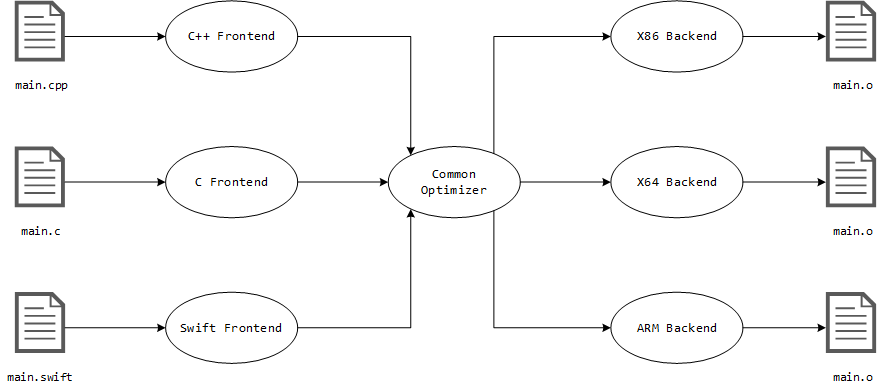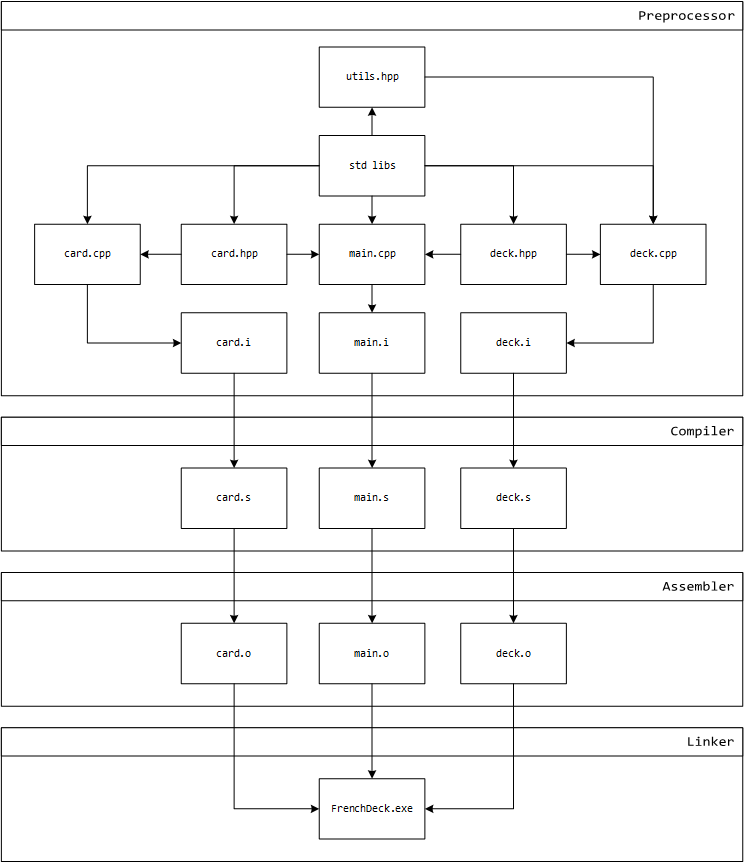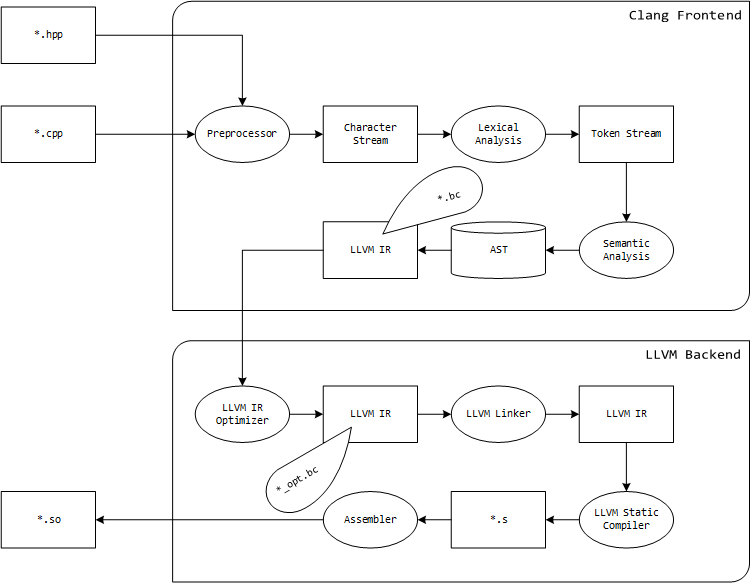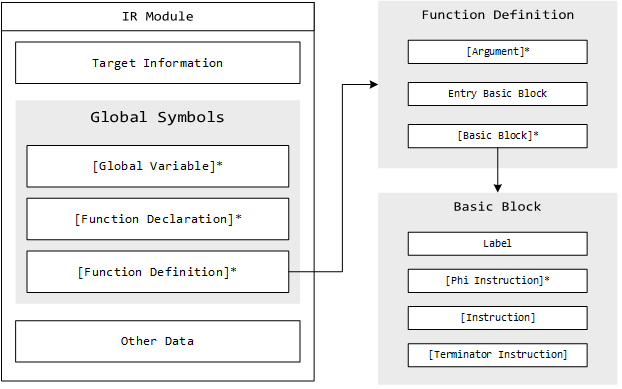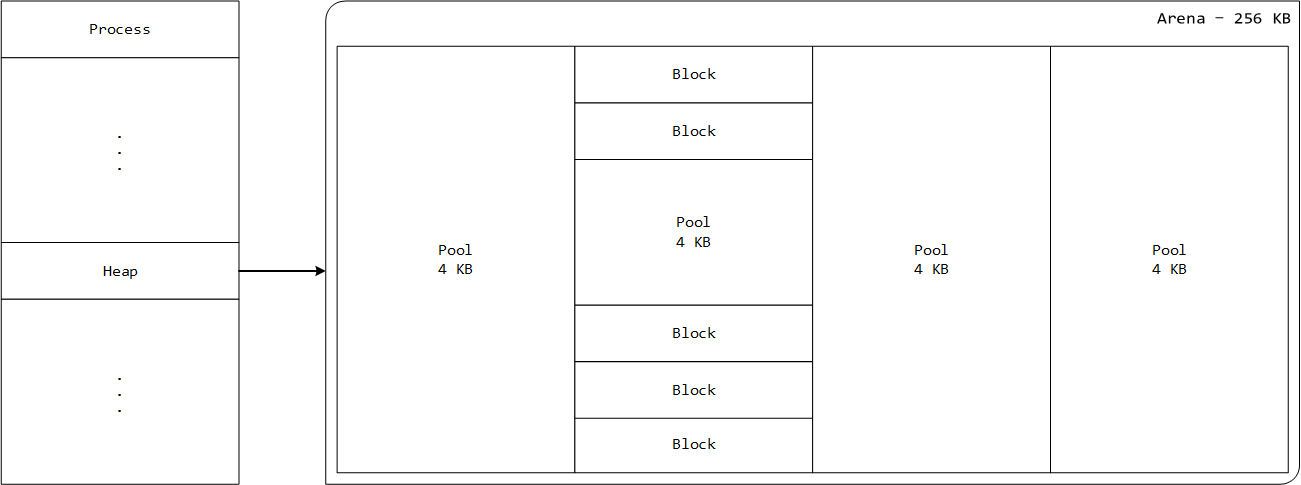Preamble
If you’re a beginner and started to learn C++ very recently, read the chapters Preprocessor, Compiler, Linker, and Conclusions first. For the most part, all definitions and explanations in these chapters are compiler-independent. Come back to this document later after you moved on from writing terminal applications exclusively. The remaining chapters provide additional information by example of LLVM/Clang. See also the Appendix and Bibliography for further reading.
Introduction
For many developers who have primarily worked with interpreted languages such as Python or JavaScript in the past, learning C++ may seem like a daunting task at first: There’re many moving parts between your hello_world.cpp and final executable that you can’t simply ignore, especially if you’re keen on developing cross-platform programs or want to collaborate with developers who use a different operating system. In this document you will learn what is happening behind the scenes when you build a C++ project. After reading this text you should be able to explain the build process more precisely without going into implementation details. It also serves as a starting point in case you want to learn more about compilers.
Preprocessor
A preprocessor directive uses the pound character (#) to designate a preprocessor
statement. These directives give rise to various events, such as
- file inclusion (
#include) in which the file being processed incorporates the content of another file. - macro substitution (
#define) to denote a sequence of text that is to be replaced by a definition. - conditional preprocessor directives (
#ifdefor*#if defined) for introducing conditions under which segments of code shan’t compile**.
The preprocessor takes precedence over the compiler. Once this step is executed, all preprocessor directives are removed from the source file. Files that go through this translation process turn into translation units that only exist in memory.
*These two are not exactly the same, see also: https://stackoverflow.com/questions/135069.
**This directive is primarily used for header guards, but it can also be used to
denote sections in code that are specific to the operating system, for example
#if defined(__ANDROID__).
Compiler
Creating a binary executable from C++ code is a multistage process that can be divided into two major steps: compiling and linking. Each of these steps goes through a magnitude of sub-routines whose end goal is to produce a binary executable file that is used to run the main application. Alternatively, compilers are also capable of creating a static or shared library that can be used in other projects. Prominent examples include, amongst other things:
- Boost: a set of 164 individual libraries that range from Algorithm to YAP, an expression template library for C++14 and later.
- STL: a standard template library.
- Qt: a tried-and-tested cross-platform widget toolkit for creating highly customizable GUIs.
- SFML: a simple and fast multimedia library living up to its name.
- OpenCV: a high-performance image processing library.
There are many C++ compilers out there, but the ones most commonly used probably are:
- Clang
- GCC
- MSVC
- Intel C++ Compiler
The main purpose of a compiler is to translate a high-level language into a transient lower-level language, for example assembly. In [1], a compiler is defined as a program that automatically translates a program text into a suitable instruction sequence before it is processed by a computer where the text to be translated is called source code (or sometimes source text). Note that some compilers don’t use an assembler in an intermediate step at all, but rather directly emit byte code into an object file. In the simplest terms, an object file consists of three things:
- Ranges of unsplittable data (sections and atoms)
- Names that define or reference data (symbols)
- Lists of modifications to data (relocations)
In many cases the compiler is able to produce more efficient assembly code than if it were handwritten. One of its main responsibilities is to ensure that the code follows the rules of the C++ programming language. During this step the compiler also performs a series of optimization techniques where applicable (inter alia constant folding and function inlining) before the assembler transforms this intermediate product into object code. Bear in mind that many compilers turn off all optimizations by default to improve the debug experience. They’re the penultimate result of the build process and contain machine code with unresolved external dependencies that are fed into the linker in the next stage. Some compilers provide support for multiple languages or target architectures which is one of the many compelling reasons to use them over others. In comparison, a traditional static compiler uses a three-phase design whose major components are the frontend, optimizer and the backend [2].
- Frontend: Performs lexical and syntax analysis as well as type checking, the result of which is the abstract syntax tree (AST) that represents the structure of the source text.
- Optimizer: Derives information from the intermediate code representation (IR) in order to recognize instructions that can be replaced with functionally equivalent optimizations.
- Backend: Generates machine-dependent optimizations (for example peephole optimizations in assembly). This code targets a specific CPU architecture.
LLVM (Low Level Virtual Machine) takes this design to the next level by implementing a modular compiler system that provides an interface for many different languages. The advantage of this design is the common optimizer that can be repurposed for different compiler frontends, while also redirecting development efforts into a single component which further increases the quality of the compiler that is now backed by a larger community.
There are other reasons why commercial application developers would prefer LLVM over other compilers such as GCC: it is licensed under a BSD-style Apache License v2.0 as opposed to GCC v4.3+ which uses the less permissive copyleft GPLv3 license that is not viable for propriety projects [3]. However, this is not the decisive factor for small applications written by independent developers or students. In many cases, using the GPLv3 license for a project would be more beneficial for the open-source software community*.
Most compilers provide a set of increasingly performant optimization options that can be controlled by explicitly enabling their respective flags. Starting with v11.0, Clang has changed its optimization flags to match the defaults of GCC. In case of Clang, it defines these flags as followed**:
O0: On this level, no optimization pass is enabled. It compiles the fastest and generates the most executable code.O1: Somewhere between-O0and-O2.O2: Moderate level of optimization which enables most optimizations.O3: Like-O2, except that it enables optimizations that take longer to perform or that may generate larger code (in an attempt to make the program run faster).Ofast: Enables all the optimizations from -O3 along with other aggressive optimizations that may violate strict compliance with language standards.Os: Like-O2, with extra optimizations to reduce code size.Oz: Like-Os(and thus like-O2) but reduces code size further.Og: Like-O1. In future versions, this option might disable different optimizations in order to improve debuggability.O: Equivalent to-O1.O4(and higher): Currently equivalent to-O3.
Building projects for release purposes is a whole topic on its own and is not going to be covered in this document in any more detail.
*For a more thorough explanation visit: https://www.gnu.org/licenses/rms-why-gplv3.html
**See also https://clang.llvm.org/docs/CommandGuide/clang.html for a comprehensive list of command line options.
Linker
The final element in the chain of the build process is the linker. It takes the object files that were produced by the compiler in the previous step and resolves all symbols in other files.
On a related note, an important term that often appears in this context is the word linkage. A distinction is drawn between internal and external linkage. Internal linkage refers to any identifier whose accessibility is limited to a single translation unit. By contrast, external linkage refers to any identifier that is accessible by other translation units via a forward declaration.
At first glance it might seem strange to separate the compilation process from the linker. But there are several advantages to this design:
- A modular design enables the compiler to work with different but compatible linkers.
- The implementation complexity of the compiler is possibly reduced if both steps are distinct from each other (e.g., during compilation it can assume that a function is defined in another file).
- Because the linker springs into action as a post-compilation process, modifying a single header file does not necessarily induce the re-compilation of all project files (with the exception of any file that includes this header), one consequence of which is the fact is that the complete build process takes up less time.
- This distinction also enables multi-threaded compilation which further speeds up the build process.
On top of that there are more benefits to this approach. Understanding the difference between compilation and linking makes it easier to interpret bugs in code. Error messages often indicate at which stage an error was detected:
LNK2019: unresolved external symbol 'symbol' referenced in function 'function'.C2661: 'function': no overloaded function takes number arguments.
In general, the compiler is capable of generating more precise error messages because it has access to the abstract syntax tree (or an intermediate code representation in case of Clang), which is why it can reason better about the code at hand. Therefore, it is a good idea to write code in a way that any possible errors are caught by the compiler rather than by the linker.
LLVM
It is worth mentioning that there exist many compiler-specific preprocessor directives.
For portability reasons it is encouraged to avoid using them, though there is one
exception to this rule* (#pragma once). In general, a compiler is best thought
of as a collection of seven sequential phases, though in reality their implementation
is more intertwined than distinct from each other.
- Preprocessing: Evaluates all preprocessor directives (string concatenation) in memory and creates a character stream for further processing.
- Lexical Analysis: Reads and analyzes the incoming character stream by dividing it into tokens, each of which corresponds to a certain symbol in the source language (for example keywords, variable names or numbers).
- Syntax Analysis: Parses the token stream and produces an abstract syntax tree that reflects the structure of the program.
- Type Checking: Examines the abstract syntax tree and determines if the program violates the semantic rules of the language (for example when a variable is used but not declared, or when a Boolean value is treated like a function pointer).
- Intermediate Code Generation: Translates the program into a machine-independent language (for example LLVM IR). This is also where most of the code optimization takes place.
- Machine Code Generation: Translates LLVM IR to assembly language for a specific machine architecture.
- Assembly and Linking: The assembler creates an object file, i.e., determines a binary representation and addresses of variables, function names, and so on [5].
When the source language is also the implementation language** and the source text to be compiled is actually a new version of the compiler itself, the process is called bootstrapping*** [4]. In case of C or C++ it is more appropriate to say that an ahead-of-time compilation (AOT) takes place when the IR is lifted down to native machine code before the program is executed. This is different from using a just-in-time (JIT) compiler in an alternative implementation of Python.
*Further reading: https://en.wikipedia.org/wiki/Pragma_once
**The language the compiler itself is written in.
***This is an advanced topic that is outside the scope of this document. For more information see also: https://en.wikipedia.org/wiki/Compiler-compiler.
LLVM IR is a RISC-like set of instructions that is capable of expressing statically
typed high-level language constructs with an infinite amount of function local
registers and is available in form of two file formats, bitcode (.bc) and human-readable
code (.ll). This intermediate code generation makes it possible to link files
that were originally written in different high-level languages, such as C, C++,
Go, Rust or Swift and enables efficient code optimization. At its core, an IR module
consists of three things: target information, global symbols and miscellaneous
other data.
The target information starts with a pair of strings describing the target. For example, the target layout string describes:
- The endianness
- ELF mangling
- ABI alignment of i64
- Native integer widths
Moreover, the target triple string contains information about
- The architecture
- Vendor
- System
- ABI
A function definition, for instance, contains zero or more arguments, an entry block as well as zero or more basic blocks. A basic block contains a label, zero or more phi instructions, and zero or more instructions followed by the terminator instruction. One of the main characteristics of a basic block is the control sequence: it is written in SSA-form (Static Single Assignment), meaning that each register is assigned exactly once which greatly simplifies control flow analysis. Phi instructions return one value from a set of incoming values based on the control flow path taken during execution to reach the phi instruction where each value is associated with a predecessor basic block. An instruction performs arithmetic operations or accesses the memory but doesn’t alter the flow of the program. The terminator instruction determines the control flow transfer once the basic block finishes its execution.
Python Interpreter
In order to obtain a thorough understanding of compilers, it is necessary to learn how interpreters work and operate. By drawing this comparison between compilers and interpreters it is possible to appreciate the benefits, but also acknowledge the disadvantages both systems entail. By example of Python this section walks through the design of an interpreter at a high-level which will be rounded up with a subsequent evaluation in the next chapter.
At the highest level, the Python interpreter consists of two components: a compiler that produces platform-independent bytecode, and the PVM (Python Virtual Machine) which interprets and subsequentially executes the program. In addition to that, the PVM accepts custom user input as well as pre-compiled library modules before it goes over to execute the program.
At the second-highest level, the Python interpreter can be divided into three major components: Parser, Compiler and PVM. Inside the parser, the scanner removes all comments, white spaces, etc. to create a token stream that is passed on to the Python parser, which in turn creates a parse tree. Note that the parse tree does not contain any automated or symbolic connection between grammar specification and the individual nodes in the parse tree. This parse tree is converted into an abstract syntax tree by the AST converter. The AST is the highest-level representation of the program structure where each AST node contains information about statements, expressions, and several other specialized types like list comprehension and exception handlers. The code generator takes the AST and translates it into a CFG (Control Flow Graph) that can be thought of as an IR (intermediate representation) within the blocks.
Basic blocks themselves are a block of IR with one entry point (that is the target of something with the potential of changing the control flow) and possibly multiple exit points which can change the flow of the program by using jumps or return statements. Bytecode is generated directly from the CFG by doing a post-order depth-first search on the CFG following the edges. After that the bytecode goes through the peephole optimizer before it enters the PVM. From then on, there are two possible paths that can be taken before the program execution takes place:
- CPython is the reference implementation of the Python programming language which utilizes a bytecode interpreter to trigger the program execution.
- Alternative language implementations (such as Numba*, PyPy** or IronPython***) employ a JIT compiler to reduce the overhead that is caused by the interpreter by translating the bytecode into machine code instructions which often improves the performance of the program significantly.
*Numba is an open-source JIT compiler that translates a subset of Python and NumPy code into machine code by using the LLVM compiler library.
**Uses an interpreter written in RPython and a JIT compiler to translate the source code into machine code instructions.
***Targets Microsoft’s .NET framework and uses its JIT compiler to improve the program execution time. This implementation also removes the python’s built-in GIL (Global Interpreter Lock).
In CPython, memory is pooled in a single location for easy allocation and removal. Because memory allocation for all needed memory in the compiler registers that memory with the arena, a single call to free the arena is all that is needed to completely free all memory used by the compiler [6]. Python stores all data structures in a private heap which is managed by Python’s memory manager and can be divided into four distinct types [7]:
- Heap is a collection of all memory managed by Python.
- Arenas are the largest chunks of memory which have a fixed size of 256 KB each. Python requests them from the system and they are the object that make up the heap.
- Pools are chunks of memory stored as arrays that make up the arenas that measure 4 KB each.
- Blocks have a specific format based on their data types. Python objects are stored in blocks. For example, an integer takes up more space than a character. For sake of efficiency, a different block size is used to store that object.
In summary, memory allocation and deallocation are handled by the GC (garbage collector) run by the PVM. Objects that go out of scope become eligible for release by the GC. Hence, virtually most of the time manual memory management can be completely ignored by the programmer.
Conclusions
While it is not wrong to say that Python is an interpreted language, this is not the whole story. The truth is that it is both an interpreted and compiled language. Because the PVM interpretates the bytecode instructions line-by-line, it is able to immediately react to changes made in the source code, though this interpretation step prolongs the program execution.
As opposed to GCC or Clang, the Python interpreter executes bytecode rather than machine code instructions. In this case, tradeoffs are made between the time it takes to analyze the source code and the overall execution time. Since no intermediate object code is generated, Python code is generally slower than compared to statically typed languages like C++ because it requires type conversion validation at runtime [7]. Moreover, since Python facilitates the use of a GC, it takes longer for the program to identify and allocate free memory. On top of that, the GC is also not thread-safe which is the primary reason why Python requires a GIL. Dynamically typed languages in general take longer to execute because they cannot employ the benefits of platform-specific machine instructions that were optimized for a particular architecture.
Appendix
This section defines many terms that were previously mentioned but not sufficiently explained in alphabetical order.
Constant Folding is an optimization technique employed by the compiler to evaluate constant expressions at compile-time rather than runtime. For example, arithmetic expressions such as
int area = 40 * 50;will substitute the RHS with the result of this computation, i.e.,2000.Function Inlining is a compiler optimization that replaces a function call site with the implementation of the function. In contrast, a macro substitution takes place one step earlier, during the preprocessor stage which effectively changes the source code processed by the compiler in memory.
IPA (Interprocedural Analysis) is a mechanism that performs optimizations across the whole program which includes, among other things:
- CS (Code Straightening)
- PP (Program Partitioning)
- IPAA (Interprocedural Pointer Alias Analyses)
- ICP (Interprocedural Copy Propagation)
Generally speaking, it refers to gathering information about the entire program instead of a single procedure.
IPO (Interprocedural Optimization) is an automatic multi-step process that employs the compiler to analyze and assess which optimizations the code could benefit from. The compiler can choose from a variety of optimization techniques*:
- ADP (Array Dimension Padding)
- CP (Common Propagation)
- PDCE (Partial Dead Call Elimination)
- WPA (Whole Program Analysis)
As opposed to IPA, it concerns itself with program transformations that involve more than one procedure in a program.
LTO (Link Time Optimization) is a method for achieving better runtime performance through whole-program analysis and cross-module optimization. During the compile phase, Clang will emit LLVM bitcode files and invokes LLVM during the link to generate the final objects that will constitute the executable. The LLVM implementation loads all input bitcode files and merges them together to produce a single Module. The interprocedural analysis (IPA) as well as the interprocedural optimizations (IPO) are performed serially on this monolithic module [8].
NRVO (Named Return Value Optimization) is a compiler optimization that can remove instantiated intermediary objects that are unique. The compiler is able to apply this technique if it is able to determine an object’s memory location inside a function where all paths return a unique object.
Peephole Optimization is a compiler optimization technique that takes a small set of compiler-generated instructions (dicitur peephole) and replaces it with a functionally equivalent, but more performant set of instructions.
RVO (Return Value Optimization) is a compiler optimization that involves eliminating the temporary object created to hold a function’s return value.
*This is a non-exhaustive list of optimizations that is available to the compiler.
Bibliography
- [1] N. Wirth, Compiler Construction, Addison-Wesley, 1996.
- [2] C. Lattner, “The Architecture of Open Source Applications,” [Online]. Available: http://www.aosabook.org/en/llvm.html. [Accessed 29 March 2021].
- [3] D. Fandrey, “Clang/LLVM Maturity Report,” Department of Computer Science of the Karlsruhe University of Applied Sciences, 2010.
- [4] D. Grune, Modern Compiler Design, Wiley, 2000.
- [5] T. A. Mogensen, Basics of Compiler Design, 2000.
- [6] “Design of CPython’s Compiler,” [Online]. Available: https://devguide.python.org/compiler/. [Accessed 04 April 2021].
- [7] F. Z. Darakshan, M. Javed and M. Pasha, “Comparative Analysis of C++ and Python in Terms of Memory and Time,” Department of Software Engineering and Technology, Karachi, Pakistan, 2020.
- [8] T. Johnson, M. Amini and D. Li, “The LLVM Project Blog - ThinLTO: Scalable and Incremental LTO,” 21 June 2016. [Online]. Available: http://blog.llvm.org/2016/06/thinlto-scalable-and-incremental-lto.html. [Accessed 2 April 2021].


